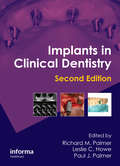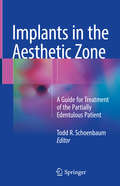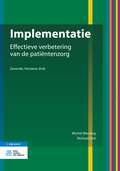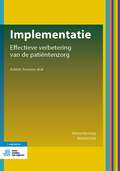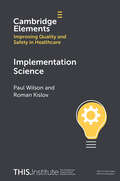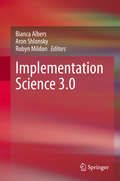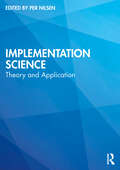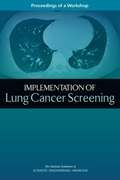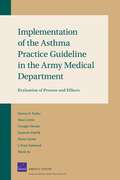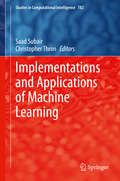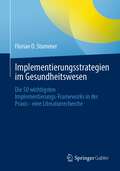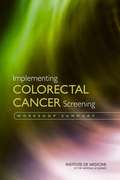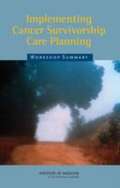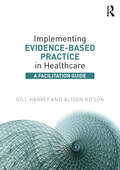- Table View
- List View
Implantable Medical Devices and Healthcare Affordability: Exposing the Spiderweb
by Mark C. West Michael Georgulis, Jr.The United States spends more than 17% of its GDP on healthcare, while other developed countries average 8.7% of GDP on healthcare expenditures. All this spending doesn’t equate to value, quality, or performance, however. Among 11 high-income countries, the United States healthcare industry ranked last during the past seven years in four key performance categories: administrative efficiency, access to care, equity, and healthcare outcomes. This book presents the implantable medical device (IMD) supply chain ecosystem as a microcosm of how these challenges of affordability and healthcare outcomes are created and are allowed to fester. The IMD Spiderweb, as the authors call it, is exposed as an example of how a wide range of participants—including physicians, health system CEOs, group purchasing organizations, health insurance companies, and supply chain executives—become ensnared in a web designed to benefit only one player. Health systems in the United States pay as much as six times more for some IMDs than their counterparts do in Europe, and prices for the same IMD model vary even among different U.S. hospitals. While there is a fascination with the latest and greatest device, there is also a shroud around visibility into how these products have performed and are likely to perform in patients. The costs continue to rise not only in healthcare expenditures, but also in death and disability. The IMD Spiderweb is presented as a prime lesson in the challenges in healthcare affordability and outcomes that occur throughout the entire healthcare industry. It is also put forward as an opportunity. The story behind how these challenges arose and continue to be deepened by the current healthcare ecosystem also provides a foundation for solutions.
Implantable Medical Electronics
by Vinod Kumar KhannaThis book is a comprehensive, interdisciplinary resource for the latest information on implantable medical devices, and is intended for graduate students studying electrical engineering, electronic instrumentation, and biomedical engineering. It is also appropriate for academic researchers, professional engineers, practicing doctors, and paramedical staff. Divided into two sections on Basic Concepts and Principles, and Applications, the first section provides an all-embracing perspective of the electronics background necessary for this work. The second section deals with pacing techniques used for the heart, brain, spinal cord, and the network of nerves that interlink the brain and spinal cord with the major organs, including ear and eye prostheses. The four main offshoots of implantable electronics, which this book discusses, are: The insertion of an implantable neural amplifier for accurate recording of neural signals for neuroengineering studies The use of implantable pulse generators for pacing the activities of diseased organs The use of implantable sensors for observing the influence of therapy and monitoring a patient's biological parameters The use of drug delivery systems to supervise the supply of accurate doses of medicine to affected parts Readers will also find chapters on the ess entials of clocking and timing circuits, pulse generator circuits, neural amplifiers, batteries, biomaterials and biocompatibility, and more. Unique to this book is also a chapter on cyber security and confidentiality concerns with implants. End-of-chapter questions and exercises help readers apply the content to practical use, making this an ideal book for anyone wishing to learn more about implantable devices.
Implantable Neural Prostheses 1
by David Zhou Elias GreenbaumThis book and its companion volume describe state-of-the-art advances in techniques associated with implantable neural prosthetic devices and their applications. Researchers, engineers, clinicians, students and any specialist in this field will gain a deeper understanding of the neural prosthetic techniques currently available for a wide range of biomedical applications. In part one of this two-volume sequence, Implantable Neural Prostheses 1: Devices and Applications, the focus is on implant designs and applications. Devices covered include sensory prosthetic devices such as cochlear implants, auditory midbrain implants, visual implants, spinal cord stimulators, and motor prosthetic devices including deep brain stimulators, Bions, and cardiac electro-stimulators. Readers will also understand the regulatory approval process in the U.S. and Europe for implantable medical devices.
Implantable Sensors and Systems
by Guang-Zhong YangImplantable sensing, whether used for transient or long-term monitoring of in vivo physiological, bio-electrical, bio-chemical and metabolic changes, is a rapidly advancing field of research and development. Underpinned by increasingly small, smart and energy efficient designs, they become an integral part of surgical prostheses or implants for both acute and chronic conditions, supporting optimised, context aware sensing, feedback, or stimulation with due consideration of system level impact.From sensor design, fabrication, on-node processing with application specific integrated circuits, to power optimisation, wireless data paths and security, this book provides a detailed explanation of both the theories and practical considerations of developing novel implantable sensors. Other topics covered by the book include sensor embodiment and flexible electronics, implantable optical sensors and power harvesting. Implantable Sensors and Systems – from Theory to Practice is an important reference for those working in the field of medical devices. The structure of the book is carefully prepared so that it can also be used as an introductory reference for those about to enter into this exciting research and developing field.
Implantat-Akupunktur: Präzisionstherapie für neurologische und psychosomatische Krankheiten sowie für chronische Schmerzerkrankungen
by Rolf Wlasak Stefan LobnerDas Praxisbuch zur Implantat-Akupunktur In dieser Neuauflage werden neben den Grundlagen und Methoden die wichtigsten Indikationen zur Anwendung der Implantat-Akupunktur vorgestellt, insbesondere: Morbus Parkinson Restless Legs Syndrom Multiple Sklerose Depressionen ADHS und Chronische Schmerzerkrankungen Was ist Implantat-Akupunktur? Mini-Implantate werden dauerhaft (Titan-Implantate) oder vorübergehend (auflösbare Implantate) unter die Haut der äußeren Ohrmuschel gesetzt. Hierdurch werden körpereigene Botenstoffe (wie z.B. Dopamin, Serotonin und Endorphin) innerhalb des zentralen Nervensystems freigesetzt, um neurologische, psychosomatische und andere chronische Erkrankungen wirksamer und nachhaltiger zu behandeln. Das Buch richtet sich an alle Ärztinnen und Ärzte, die diese wirksame Methode der Akupunktur kennenlernen und in der Praxis umsetzen möchten.
Implantaten en prothetische constructies: Een inleiding voor mondhygiënisten
by C. Baat G. M. Raghoebar W.F.M. Pelkmans-TijsNu behandelingen met implantaten steeds meer voorkomen, is theoretische en praktische scholing van mondhygiënisten op dit gebied een dringende behoefte.Implantaten en prothetische constructies beschrijft beknopt het hele traject van een behandeling met implantaten: van het opstellen van het behandelplan tot en met de nazorg. Uitgangspunt is de behandeling van een edentate onderkaak met een overkappingsprothese op implantaten, maar ook de bovenkaak en gedeeltelijk tandeloze kaken krijgen aandacht.Met de kennis die aan de hand van dit boek wordt opgedaan, is het mogelijk de orale weefsels en de implantaten met de daarop vervaardigde prothetische constructies onder controle te houden en patiënten met orale implantaten te begeleiden bij de benodigde zelfzorg.Deze publicatie is bestemd om mondhygiënisten de nodige basisinformatie te geven over de relevante aspecten van de orale implantologieDeze publicatie is bestemd om mondhygiënisten de nodige basisinformatie te geven over de relevante aspecten van de orale implantologie
Implantation and Early Development
by Stephen Smith Hilary Critchley Iain CameronSuccessful implantation and early development need a union of healthy genes and an optimal uterine environment. The 48th RCOG Study Group, an international multidisciplinary expert forum, considered factors involved in preparation for implantation within the uterus, what makes a good egg and sperm and hence a good embryo. Lessons from animal models and transgenic and genomic technologies considered. The group looked at sporadic and recurrent early pregnancy loss and discussed new treatment options. Discussion also included single-embryo transfer and the developmental consequences of assisted reproduction technologies. This publication provides a valuable resource for gynaecologists, specialist nurses, embryologists, base scientists and all those with an interest in early pregnancy and development.
Implants and Oral Rehabilitation of the Atrophic Maxilla: Advanced Techniques and Technologies
by Marco RinaldiThis book covers the most suitable techniques for the rehabilitation of patients experiencing tooth loss, trauma or other situations resulting in bone atrophy. The book discusses current technologies, from diagnosis to treatment and surgery, applied to atrophic jaws using innovative tools and new PSI (patient specific implant) approaches. Oral Rehabilitation of the Atrophic Maxilla and the selection of the best treatment options for patients is one of the most difficult tasks facing the profession today. Readers will be able to solve complex problems and evaluate all available applications for patient management. Zygomatic implants, reconstructive surgery with bone grafts, post-oncologicasl and post traumatic reconstructions as well as dynamic navigation and robot assisted dental surgery are covered. The book is written by recognized experts and leaders in the field, and includes simpler techniques within the reach of many implantologists and more complex techniques that require specific surgical skills. It is relevant for, implanologist, periodontists, oral and maxillofacial surgeon, prosthodontists and every clinician treating maxillary atrophy.
Implants in Clinical Dentistry
by Leslie C. Howe Richard M. Palmer Paul J. PalmerThe second edition of the bestselling guide, Implants in Clinical Dentistry, considers the practical features that a clinician needs to know for successful treatment planning, surgical implantation, and long-term maintenance.Illustrated with full colour clinical images and authored by a team from King's College London Dental Institute, this is an i
Implants in the Aesthetic Zone: A Guide for Treatment of the Partially Edentulous Patient
by Todd R. SchoenbaumThis book concisely elucidates the science underlying implant treatment in the aesthetic zone in partially edentulous patients and clearly describes the techniques and protocols used by world-leading experts in the field. The book is divided into four parts that address treatment planning; site preparation (hard and soft tissue augmentation); immediate implant placement and provisional restoration; and the design, fabrication, and delivery of the definitive implant prosthesis. Complex cases of this nature present a significant challenge to even the most well informed and experienced of doctors. Implants in the Aesthetic Zone has been specifically crafted to meet all the needs of the clinician involved in their management, providing a reliable road map for interdisciplinary implant treatment in clinical practice. The authors have been carefully selected from a wide range of fields for their expertise in particular areas of implant science or treatment.
Implementatie: Effectieve verbetering van de patiëntenzorg
by Richard Grol Michel WensingDit boek helpt zorgverleners, leidinggevenden, staffunctionarissen, beleidsmakers en onderzoekers om pati#65533;ntenzorg op een effectieve manier te verbeteren. Het geeft een praktische, stapsgewijze aanpak voor de implementatie van innovatie in de gezondheidszorg, die rekening houdt met de weerbarstigheid van de praktijk. In Implementatie ligt de nadruk op het verbeteren van het handelen van artsen, verpleegkundigen, paramedici, andere zorgverleners, en de teams waarin zij werken. De pati#65533;nt staat hierbij centraal. Deze geactualiseerde uitgave geeft een toegankelijk overzicht van het wetenschappelijk onderzoek op het gebied van implementatie. Het beantwoordt bijvoorbeeld de vraag hoe het komt dat veel waardevolle inzichten, hulpmiddelen, programma's en best practices de weg naar de praktijk niet vinden. En andersom hoe het kan dat er soms werkwijzen gebruikt worden waarvan is aangetoond dat ze geen meerwaarde hebben voor pati#65533;nten of burgers. Implementatie beschrijft vele concrete voorbeelden van verandertrajecten in Nederland en daarbuiten. Bij het boek horen digitale verrijkingen, zoals samenvattingen van de hoofdstukken en toetsen met multiplechoicevragen en stellingen.
Implementatie: Effectieve verbetering van de patiëntenzorg
by Richard Grol Michel WensingDit boek helpt zorgverleners, leidinggevenden, staffunctionarissen, beleidsmakers en onderzoekers om patiëntenzorg op een effectieve manier te verbeteren. Het geeft een praktische, stapsgewijze aanpak voor de implementatie van innovaties in de gezondheidszorg, die rekening houdt met de weerbarstigheid van de praktijk.In Implementatie ligt de nadruk op het verbeteren van het handelen van artsen, verpleegkundigen, paramedici, andere zorgverleners, en de teams waarin zij werken. De patiënt staat hierbij centraal. De uitgave geeft een toegankelijk overzicht van het wetenschappelijk onderzoek op het gebied van implementatie. Het beantwoordt bijvoorbeeld de vraag hoe het komt dat veel waardevolle inzichten, hulpmiddelen, programma’s en best practices de weg naar de praktijk niet vinden. En andersom hoe het kan dat er soms werkwijzen gebruikt worden waarvan is aangetoond dat ze geen meerwaarde hebben voor patiënten of burgers. Hierbij wordt nadruk gelegd op de rol van contextfactoren bij verbetering en implementatie. De vele concrete voorbeelden van verandertrajecten in Nederland en daarbuiten vullen dit overzicht aan.Implementatie in de zorg mag zich verheugen in een groeiende belangstelling van wetenschap en praktijk. Deze achtste editie bevat daarom veel nieuwe ontwikkelingen en actuele voorbeelden. Het boek is compacter geschreven en een aantal hoofdstukken is grondig herzien. Het resultaat is een omvattend, actueel en praktisch toepasbaar overzicht van de kennis op het gebied van verbetering van de patiëntenzorg.
Implementation Science (Elements of Improving Quality and Safety in Healthcare)
by Paul Wilson Roman KislovThis Element introduces and critically reflects on the contribution of implementation science to healthcare improvement efforts. Grounded in several disciplines, implementation science is the study of strategies to promote the uptake of evidence-based interventions into healthcare practice and policy. The field's focus is threefold. First, it encompasses theory and empirical research focused on exploring, identifying, and understanding the systems, behaviours, and practices that influence successful implementation. Second, it examines the evaluation of strategies to address barriers or enablers to implementation in a given context. Last, it increasingly seeks to understand the process of implementation itself: what actually gets implemented, and when, why, and how? Despite the growing body of evidence, challenges remain. Many important messages remain buried in the literature, and their impact on implementation efforts in routine practice may be limited. The challenge is not just to get evidence into practice, but also to get implementation science into practice. This title is also available as Open Access on Cambridge Core.
Implementation Science 3.0
by Bianca Albers Aron Shlonsky Robyn MildonThis textbook presents a much-needed overview of the recent developments in implementation science — a discipline that is young, has gained increasing attention in recent years, and has experienced substantial and rapid growth in knowledgeproduction and debate. It captures the latest developments in research and pushes the reader toward the next phase for implementation science: bridging the science-to-practice divide. Drawing from multidisciplinary, international research by top scholars in the field, this book provides a critical but friendly approach to understanding what implementation science is, what it isn’t, and where it’s going.Topics include:• Factors associated with effective implementation• Organizational context and readiness for change• Implementation theories, models, and frameworks• Enhancing implementation measurement• Bringing interventions to scale• Closing the science-practice gap in implementationImplementation Science 3.0 is a timely, important resource for researchers, students, and others with an interest in implementation working across the fields of social welfare,public health, education, and psychology.The chapter “Making sense of implementation theories, models and frameworks”,in which some modifications to the text were made, is available open access under a Creative Commons Attribution 4.0 International License in Nilsen, P. (2015). Implementation Science, 10(53), via link.springer.com.
Implementation Science in Nursing: A Framework for Education and Practice
by Patricia Thomas Linda RousselA timely resource that shows faculty, students, and clinicians how to bring about and sustain change, Implementation Science in Nursing: A Framework for Education and Practice provides theoretical information and practical application for evidence-based practice (EBP) in health care.The most challenging but crucial part of EBP is implementation, where the practice change is piloted, evaluated, integrated, and sustained. Implementation Science in Nursing: A Framework for Education and Practice focuses on the implementation process, which is the study of methods and strategies that promote the methodical uptake of research findings and EBPs into routine practices to ultimately improve patient care, quality, safety, and outcomes. Drs. Linda A. Roussel and Patricia L. Thomas have combined both didactic teaching methods with real-life exemplars in the text to help readers learn the elements of implementation science and its application. Other important features include: • Excellent exemplars and sample assignments for educators• In-depth discussions on implementation science theories, models, and frameworks applied to real-life scenarios• Thorough explanations of evidence-based practice (EBP), quality improvement (QI) implementation science (IS), and dissemination science (DS)• The latest literature and thinking on implementation scienceWith Implementation Science in Nursing: A Framework for Education and Practice, nursing professionals and students in Doctor of Nursing Practice programs will learn the tools, techniques, and strategies used to advance quality initiatives and improve patient and population health.
Implementation Science: The Key Concepts (Routledge Key Guides)
by Jeffrey Braithwaite Frances Rapport Robyn Clay-WilliamsThis accessible textbook introduces a wide spectrum of ideas, approaches, and examples that make up the emerging field of implementation science, including implementation theory, processes and methods, data collection and analysis, brokering interest on the ground, and sustainable implementation. Containing over 60 concise essays, each addressing the thorny problem of how we can make care more evidence-informed, this book looks at how implementation science should be defined, how it can be conducted, and how it is assessed. It offers vital insight into how research findings that are derived from healthcare contexts can help make sense of service delivery and patient encounters. Each entry concentrates on an important concept and examines the idea’s evidence base, root causes and effects, ideas and applications, and methodologies and methods. Revealing a very human side to caregiving, but also tackling its more complex and technological aspects, the contributors draw on real-life healthcare examples to look both at why things go right in introducing a new intervention and at what can go wrong. Implementation Science: The Key Concepts provides a toolbox of rich, contemporary thought from leading international thinkers, clearly and succinctly delivered. This comprehensive and enlightening range of ideas and examples brought together in one place is essential reading for all students, researchers, and practitioners with an interest in translating knowledge into practice in healthcare.
Implementation Science: Theory and Application
by Per NilsenThis core textbook introduces the key concepts, theories, models and frameworks used in implementation science, and supports readers applying them in research projects. The first part of the book focuses on the theory of implementation science, providing a discussion of its emergence from the evidence-based practice movement and its connections to related topics such as innovation research. It includes chapters looking at a wide range of theories, methods and frameworks currently used in implementation science, and a chapter focusing on suitable theories that could be imported from other fields. The first part also addresses strategies and outcomes of implementation and discusses how researchers can build causal pathways adapted to their study. The second part of the book focuses squarely on putting the theory of implementation science to work in practice, with chapters discussing research methods used in the field and how to select the most appropriate approach. This section also features several chapters presenting in-depth case studies of specific applications.This multidisciplinary text is an essential resource for graduate students from a range of healthcare backgrounds taking courses on implementation science, as well as researchers from medicine, nursing, public health, allied health, economics, political science, sociology and engineering.
Implementation of Lung Cancer Screening: Proceedings of a Workshop
by Engineering Medicine National Academies of SciencesThe public health burden from lung cancer is substantial: it is the second most commonly diagnosed cancer and the leading cause of cancer-related deaths in the United States. Given the individual and population health burden of lung cancer, especially when it is diagnosed at later stages, there has been a push to develop and implement screening strategies for early detection. However, many factors need to be considered for broad implementation of lung cancer screening in clinical practice. Effective implementation will entail understanding the balance of potential benefits and harms of lung cancer screening, defining and reaching eligible populations, addressing health disparities, and many more considerations. In recognition of the substantial challenges to developing effective lung cancer screening programs in clinical practice, the National Academies of Sciences, Engineering, and Medicine held a workshop in June 2016. At the workshop, experts described the current evidence base for lung cancer screening, the current challenges of implementation, and opportunities to overcome them. Workshop participants also explored capacity and access issues; best practices for screening programs; assessment of patient outcomes, quality, and value in lung cancer screening; and research needs that could improve implementation efforts. This publication summarizes the presentations and discussions from the workshop.
Implementation of the Asthma Practice Guideline in the Army Medical Department
by Georges Vernez Donna O. Farley Suzanne Pieklik Elaine Quiter Shan CretinIn partnership with the Army Medical Department, RAND worked to implement clinical practice guidelines. This report evaluates the asthma guideline demonstration. It documents the actions, assesses effects, and measures the quality and limitations of data for monitoring outcomes. The authors found that the implementation scored successes but resource limitations and organizational barriers curbed progress. They conclude that flexibility, monitoring, and training are the keys to implementing the guidelines. They also found that patient education needed improvement.
Implementations and Applications of Machine Learning (Studies in Computational Intelligence #782)
by Saad Subair Christopher ThronThis book provides step-by-step explanations of successful implementations and practical applications of machine learning. The book’s GitHub page contains software codes to assist readers in adapting materials and methods for their own use. A wide variety of applications are discussed, including wireless mesh network and power systems optimization; computer vision; image and facial recognition; protein prediction; data mining; and data discovery. Numerous state-of-the-art machine learning techniques are employed (with detailed explanations), including biologically-inspired optimization (genetic and other evolutionary algorithms, swarm intelligence); Viola Jones face detection; Gaussian mixture modeling; support vector machines; deep convolutional neural networks with performance enhancement techniques (including network design, learning rate optimization, data augmentation, transfer learning); spiking neural networks and timing dependent plasticity; frequent itemset mining; binary classification; and dynamic programming. This book provides valuable information on effective, cutting-edge techniques, and approaches for students, researchers, practitioners, and teachers in the field of machine learning.
Implementierungsstrategien im Gesundheitswesen: Die 50 wichtigsten Implementierungs-Frameworks in der Praxis - eine Literaturrecherche
by Florian O. StummerDie Herausforderungen des 21. Jahrhunderts für das Gesundheitswesen verlangen nach neuen und innovativen Lösungen. Meist ist jedoch die Implementierung eben dieser neuen Prozesse die größte Herausforderung für Unternehmen und Gesundheitseinrichtungen. Sei es die Einführung einer neuen Technologie oder die Etablierung eines neuen Departments - nachweislich scheitern etwa 70 Prozent aller Projekte innerhalb von 36 Monaten. In einer immer schneller werdenden, transdisziplinären Wirtschaftswelt ist es von entscheidender Bedeutung, über die richtigen Implementierungs-Instrumente zu verfügen, um langfristige strategische Veränderungen nachhaltig umsetzen zu können.Das vorliegende Kompendium gibt Ihnen die wichtigsten Implementierungs-Frameworks an die Hand, um auf die Fragestellungen ihrer Organisation effiziente Lösungsprozesse für die Zukunft entwickeln zu können. Die Auswahl erfolgte auf Basis einer wissenschaftlichen Literaturrecherche. Mit zahlreichen Best-Practice-Beispielen aus der Gesundheitsbranche.
Implementing COLORECTAL CANCER Screening: WORKSHOP SUMMARY
by Institute of Medicine of the National AcademiesThe IOM's National Cancer Policy Board estimated in 2003 that even modest efforts to implement known tactics for cancer prevention and early detection could result in up to a 29 percent drop in cancer deaths in about 20 years. The IOM's National Cancer Policy Forum, which succeeded the Board after it was disbanded in 2005, continued the Board's work to outline ways to increase screening in the U.S. On February 25 and 26, 2008, the Forum convened a workshop to discuss screening for colorectal cancer. Colorectal cancer screening remains low, despite strong evidence that screening prevents deaths. With the aim to make recommended colorectal cancer screening more widespread, the workshop discussed steps to be taken at the clinic, community, and health system levels. Workshop speakers, representing a broad spectrum of leaders in the field, identified major barriers to increased screening and described strategies to overcome these obstacles. This workshop summary highlights the information presented, as well as the subsequent discussion about actions needed to increase colorectal screening and, ultimately, to prevent more colorectal cancer deaths.
Implementing Cancer Survivorship Care Planning: Workshop Summary
by Institute of Medicine of the National AcademiesOne of the key recommendations of the joint IOM and NRC book, From Cancer Patient to Cancer Survivor: Lost in Transition, is that patients completing their primary treatment for cancer be given a summary of their treatment and a comprehensive plan for follow-up. This book answers practical questions about how this "Survivorship Care Plan," including what exactly it should contain, who will be responsible for creating and discussing it, implementation strategies, and anticipated barriers and challenges.
Implementing Evidence-Based Practice in Healthcare: A Facilitation Guide
by Gill Harvey Alison KitsonThe successful implementation of evidence into practice is dependent on aligning the available evidence to the particular context through the active ingredient of facilitation. Designed to support the widely recognised PARIHS framework, which works as a guide to plan, action and evaluate the implementation of evidence into practice, this book provides a very practical ‘how-to’ guide for facilitating the whole process. This text discusses: undertaking an initial diagnosis of the context and reaching a consensus on the evidence to be implemented; how to link the research evidence with clinical and patients’ experience and local information in the form of audit data or patient and staff feedback; the range of diagnostic, consensus building and stakeholder consultation methods that can be helpful; a description of facilitator roles and facilitation methods, tools and techniques; some of theories that underpin the PARIHS framework and how these have been integrated to inform a revised version of PARIHS Including internationally-sourced case study examples to illustrate how the facilitation role and facilitation skills have been applied in a range of different health care settings, this is the ideal text for those interested in leading or facilitating evidence based implementation projects, from the planning stage through to evaluation.
Implementing Evidence-Based Practices in Community Corrections and Addiction Treatment
by Steven Belenko Faye S. TaxmanCommunity corrections programs are emerging as an effective alternative to incarceration for drug-involved offenders, to reduce recidivism and improve public health and public safety. Since evidence-based practice is gaining recognition as a success factor in both community systems and substance abuse treatment, a merger of the two seems logical and desirable. But integrating evidence-based addiction treatment into community corrections is no small feat--costs, personnel decisions, and effective, appropriate interventions are all critical considerations. Featuring the first model of implementation strategies linking these fields, Implementing Evidence-Based Practices in Community Corrections and Addiction Treatment sets out criteria for identifying practices and programs as evidence. The book's detailed blueprint is based on extensive research into organizational factors (e.g., management buy-in) and external forces (e.g., funding, resources) with the most impact on the adoption of evidence-based practices, and implementation issues ranging from skill building to quality control. With this knowledge, organizations can set realistic, attainable goals and achieve treatment outcomes that reflect the evidence base. Included in the coverage: Determining evidence for "what works."Organization change and technology transfer: theory and literature review.The current state of addiction treatment and community corrections.Unique challenges of evidence-based addiction treatment under community supervision.Assessing suitability of evidence-based practice in real-world settings.A conceptual model for implementing evidence-based treatment in community corrections. Implementing Evidence-Based Practices in Community Corrections and Addiction Treatment is a breakthrough volume for graduate- and postgraduate-level researchers in criminology, as well as policymakers and public health researchers.








